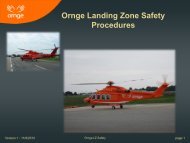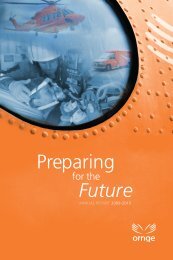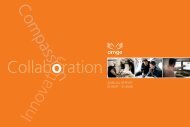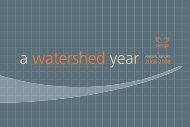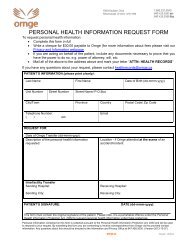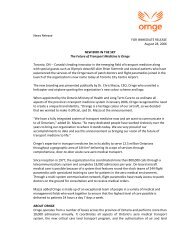Ornge Landing Zone Safety Procedures
Ornge Landing Zone Safety Procedures
Ornge Landing Zone Safety Procedures
You also want an ePaper? Increase the reach of your titles
YUMPU automatically turns print PDFs into web optimized ePapers that Google loves.
<strong>Ornge</strong> <strong>Landing</strong> <strong>Zone</strong> <strong>Safety</strong><br />
<strong>Procedures</strong><br />
Version 2- 12/4/2012<br />
<strong>Ornge</strong> LZ <strong>Safety</strong><br />
page 1
<strong>Landing</strong> <strong>Zone</strong> Coordinator Role<br />
• Select a landing site coordinator:<br />
• someone who is not involved in scene operations or patient care,<br />
• police, firefighters, or other first responders are an excellent choice<br />
• The landing zone coordinator is responsible for selecting, setting up,<br />
securing and maintaining an area for the helicopter, throughout the entire<br />
transport operation<br />
• The landing zone coordinator must remain on site and fulfill these<br />
responsibilities from the time of the initial request, until the helicopter<br />
departs the scene<br />
• The Captain of the helicopter is responsible for utilizing the selected<br />
landing zone or choosing a more appropriate, safe alternative, and always<br />
has the final decision on whether or not to land<br />
Version 2 - 12/4/2012<br />
<strong>Ornge</strong> LZ <strong>Safety</strong><br />
page 2
• 150 feet x 150 feet Minimum<br />
• If multiple sites are available, choose the best and<br />
safest option for the helicopter and its crew<br />
• Where possible the landing zone must not be<br />
boxed in by emergency vehicles unless no other<br />
option is available<br />
• Clear of obstacles (wires, trees, stumps, vehicles),<br />
or loose debris<br />
• Stable surface (concrete, asphalt, packed gravel,<br />
grass)<br />
• As flat as possible<br />
• Do not use flares or other objects to outline the<br />
landing zone<br />
• Stretchers shall be left in the ambulance and all<br />
loose articles secured until directed by pilot or<br />
crew members<br />
• Fire fighters should not lay out hose, any hoses<br />
that have been laid must be charged<br />
Minimum <strong>Landing</strong> <strong>Zone</strong><br />
Requirements<br />
Version 2 - 12/4/2012<br />
<strong>Ornge</strong> LZ <strong>Safety</strong><br />
page 3
Securing the <strong>Landing</strong> <strong>Zone</strong><br />
• Place a minimum of two vehicles, beyond each end of the designated landing zone,<br />
perpendicular to the intended landing zone (i.e. road, clear section of field, etc). This<br />
is to prevent site access to other vehicles. Personnel should also be in place to<br />
prevent access to the landing zone<br />
• If the landing zone is dusty, have the fire department wet the area down to prevent a<br />
zero visibility situation when the helicopter lands<br />
• Fresh snow should be packed down to prevent whiteout conditions. If this is not<br />
practical, warn the aircrew of loose or powder snow conditions"<br />
• Vehicles and personnel are strictly prohibited from the landing zone (radius of 150’)<br />
from a minimum of 3 minutes prior to the estimated time of arrival until there is<br />
positive and definitive indication from the flight crew it is safe to enter the landing<br />
zone<br />
• There shall be no vehicles or personnel within the landing zone at any time after an<br />
indication, verbal or physical from the flight crew that they are ready to start engines<br />
Version 2 - 12/4/2012<br />
<strong>Ornge</strong> LZ <strong>Safety</strong><br />
page 4
Communications<br />
• Determine an accurate description of the landing zone in relation to the scene<br />
location<br />
• GPS coordinates are the PREFERRED method of identifying the site and should<br />
be used conjunction with all other means<br />
• Include highway numbers and distances to nearby towns<br />
• Provide directional (compass) headings to the scene from the landmarks<br />
• Emergency service vehicle automatic vehicle locators (AVLs) can be used to<br />
provide the crew with coordinates of the accident area<br />
• All scene and landing zone location information should be relayed to local dispatch<br />
so it can be relayed to the <strong>Ornge</strong> Communications Centre and subsequently to the<br />
flight crew<br />
Version 2 - 12/4/2012<br />
<strong>Ornge</strong> LZ <strong>Safety</strong><br />
page 5
Dangerous Obstacles<br />
• The following obstacles within a 360 degree radius shall be relayed to the<br />
flight crew prior to landing:<br />
• Trees<br />
• Utility poles<br />
• Wires<br />
• Ditches<br />
• Signs<br />
• Any object that the helicopter could dislodge<br />
• Each obstacle should be identified to the pilot in relation to the landing<br />
zone, i.e. “There is a large light standard 30 feet west of the landing zone”<br />
• The two following slides will illustrate dangerous obstacles found at<br />
scenes<br />
Version 2 - 12/4/2012<br />
<strong>Ornge</strong> LZ <strong>Safety</strong><br />
page 6
On Scene Hazards<br />
Wires near LZ –<br />
Report to Flight Crew<br />
Ditch adjacent to LZ –<br />
Report to Flight Crew<br />
Road Signs near LZ -<br />
Report to Flight Crew<br />
Version 2 - 12/4/2012<br />
<strong>Ornge</strong> LZ <strong>Safety</strong><br />
page 7
Aerial View of Scene<br />
Large Sign –<br />
Report to Flight Crew<br />
Charged Line<br />
Light Standard –<br />
Report to Flight Crew<br />
Version 2 - 12/4/2012<br />
<strong>Ornge</strong> LZ <strong>Safety</strong><br />
page 8
Wind<br />
• All take-offs and landings will be made into the wind wherever possible.<br />
Wind direction should be considered when selecting a landing zone<br />
Version 2 - 12/4/2012<br />
<strong>Ornge</strong> LZ <strong>Safety</strong><br />
page 9
Hazardous Materials (HAZMAT)<br />
• Never assume the flight crew is aware of a HAZMAT danger. Always<br />
ensure the flight crew is notified as to the nature of any such dangers as<br />
soon as possible prior to landing<br />
• When hazardous materials are present, the landing zone should be<br />
located UPWIND of the incident and outside of the HOT ZONE<br />
• Rotor downwash could spread hazardous materials over 100 metres<br />
• Avoid choosing low lying areas for landing zones as vapours collect in low<br />
terrain<br />
Version 2 - 12/4/2012<br />
<strong>Ornge</strong> LZ <strong>Safety</strong><br />
page 10
Safe Distances<br />
• Spectators SHALL remain a minimum of 200 feet clear of the<br />
helicopter<br />
• Emergency vehicles SHALL remain 150 feet away until otherwise<br />
instructed by the pilot or crew members.<br />
• NO VEHICLES OR PERSONNEL are allowed within the 150’<br />
landing zone while rotors are turning without a crew escort.<br />
Version 2 - 12/4/2012<br />
<strong>Ornge</strong> LZ <strong>Safety</strong><br />
page 11
Beware of Rotor Downwash<br />
Main rotor blade tips are<br />
almost invisible when<br />
spinning<br />
Tail rotor blades are<br />
almost invisible when<br />
spinning<br />
page 12
Beware of Rotor Downwash<br />
• Helicopters generate high winds. It is essential to examine the landing zone for<br />
any loose objects or debris, as this may be picked up by rotor downwash and<br />
ingested through an engine intake. This could cause the helicopter to malfunction<br />
or even crash<br />
• Common debris includes everything that is not secure, including but not limited to<br />
pillows, blankets, tarps, loose clothing, sticks, plywood, paper, and plastic bags<br />
• Rotor downwash is capable of reaching speeds of up to 100 miles per hour<br />
• Personnel should take cover inside or behind vehicles while a helicopter is<br />
arriving or departing<br />
• Vehicle doors, windows and access compartments should be closed<br />
• Extreme caution should be exercised when a helicopter is operating in the vicinity<br />
Version 2 - 12/4/2012<br />
<strong>Ornge</strong> LZ <strong>Safety</strong><br />
page 13
Personal Protective Equipment<br />
• Ensure that all personal protective equipment worn during<br />
helicopter arrivals and departures<br />
• This includes but is not limited too:<br />
• Eye Protection<br />
• Hearing Protection<br />
• Helmet with visor down and chin strap fastened<br />
• Jacket and pants to cover bare skin<br />
Version 2 - 12/4/2012<br />
<strong>Ornge</strong> LZ <strong>Safety</strong><br />
page 14
Approaching a Helicopter<br />
• DO NOT APPROACH THE<br />
HELICOPTER WHEN THE<br />
ROTOR BLADES ARE<br />
TURNING WITHOUT A<br />
CREW ESCORT<br />
• Always look for a visual<br />
signal from the pilot that it<br />
is safe to approach before<br />
doing so<br />
• Always approach the<br />
helicopter using the<br />
safe approach corridors<br />
• If there is any doubt as to<br />
whether it is safe to<br />
approach,<br />
DO NOT APPROACH<br />
Version 2 - 12/4/2012<br />
<strong>Ornge</strong> LZ <strong>Safety</strong><br />
page 15
Safe Approach<br />
Corridors<br />
page 16
Approaching a Helicopter on<br />
Sloping Terrain<br />
• IF ON UNEVEN GROUND, approach or depart from the downhill side<br />
for maximum rotor clearance<br />
• DO NOT RAISE ANYTHING ABOVE THE HEAD and crouch while<br />
walking in the vicinity of the helicopter<br />
Version 2 - 12/4/2012<br />
<strong>Ornge</strong> LZ <strong>Safety</strong><br />
page 17
Night Operations<br />
• <strong>Ornge</strong> helicopters will only respond to heliports, airports, and company<br />
approved landing sites at night<br />
Version 2 - 12/4/2012<br />
<strong>Ornge</strong> LZ <strong>Safety</strong><br />
page 18
Any Questions or Concerns?<br />
Contact:<br />
Allison Couch<br />
Aerodrome Conformance<br />
Specialist<br />
<strong>Ornge</strong> Aviation <strong>Safety</strong><br />
acouch@ornge.ca<br />
(647) 428-2005 ext.4753<br />
Or,<br />
<strong>Ornge</strong> Transport Medicine<br />
Aviation <strong>Safety</strong><br />
aviationsafety@ornge.ca<br />
1 800 251 6543<br />
www.ornge.ca<br />
page 19



